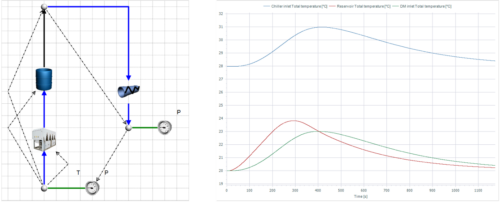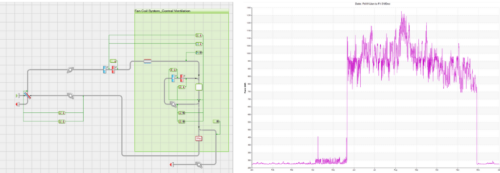
Cooling system failure in Data Centres can lead to overheating, equipment damage and downtime. Advanced physics simulations are critical for avoiding this: think shape system design, risk mitigation, improved energy efficiency. and help owners determine operational practices.
In today’s data dependant world, the operational capacity and continuous service of data centres is crucial. Stringent requirements are in place to ensure they maintain operational integrity including during fault scenarios (such as the Uptime Institute’s Tier III or IV standards). Conventionally, this resiliency is achieved through redundancy and sufficient capacity, such as backup power supplies and cooling systems. This approach however can fail to analyse and address operational risks such as the complex thermofluid dynamics of cooling, internal air flow, external weather patterns, and transient events such as power loss and restoration.
" Advanced physics simulations are key to mitigating these risks. If a cooling system fails or operates below capacity due to any of these risks, even for a short period, it can lead to overheating, equipment damage, and potential downtime beyond the allowance in the Tier III or IV design standards.
At Deerns, we use simulations to take data centre design beyond conventional redundancy by modelling dynamic behaviours within the facility’s environment. Techniques such as computational fluid dynamics (CFD) and one-dimensional (1D) thermofluids simulations provide us with critical insights that are used to optimise the design and operation of data centres. In addition, dynamic energy and thermal modelling can provide a holistic understanding of thermal response and energy demand of data centres across varying weather and usage patterns.
Harnessing Computational Fluid Dynamics (CFD) in data centres
Computational fluid dynamics (CFD) helps the Deerns team analyse and understand problems involving fluid flows including air and water. In a data centre setting, we use CFD to simulate the airflow and heat transfer within different critical spaces. This gives us a detailed understanding of how cooling systems will perform under various conditions including varying equipment loads and cooling unit operation (e.g. normal and failure modes).
CFD simulations also help us make recommendations for equipment positioning within the data centre. By modelling the air movement and heat/cool transfer within a critically cooled space, and their interaction with active equipment we can identify potential hotspots and suggest mitigation solutions.

Transient simulation with one-dimensional thermofluids modelling for data centres
1D thermofluids modelling is another powerful tool we use in data centre design and operations analysis. Unlike CFD’s three-dimensional analysis of fluid flow and heat transfer, 1D thermofluids modelling relies on the thermofluids interactions between nodes which are used to represent equipment, components, and zone spaces. This allows for faster simulation times compared to typical CFD models of the same space thereby making it possible to model the dynamic behaviour of large fluid systems over time, capturing the effects of transient events and system-wide interactions. For example, 1D modelling can be used to analyse a data centre building’s entire chilled water system and its effect on airside cooling in critical spaces.
1D simulations help predict the behaviour of cooling systems during transient events such as power loss/restoration, equipment failures, or sudden changes in load – and understand their effect on upstream and downstream operations. We can predict how a cooling system will respond over time, including how quickly temperatures will rise in the event of a failure or load change, and how long it will take for temperatures to return to safe levels once suitable capacity is restored. Our designers use this to mitigate design risks and help data centre owners and operators mitigate operational risks.
A classic example is using 1D modelling to analyse a power loss / restoration scenario. Modelling can reveal how long the cooling system can maintain safe temperatures without power and how quickly it can recover once power is restored. This is essential for ensuring that the data centre can withstand power disturbances without risking equipment overheating or downtime.


Dynamic energy and thermal modelling for data centres
This tool takes first principles energy and thermal calculations e.g. heat gain/loss, power consumption for regulated loads e.g. heat pump/chillers; and unregulated loads e.g. servers, and applies them in a dynamic environment. Accounting for changes to input conditions that occur at discrete time steps including (but not limited to) ambient weather conditions, occupancy patterns, temperature, humidity, and ventilation set points etc.
This approach, coupled with the flexibility of setting up performance parameters for the building fabric, loads, and MEP system efficiencies creates a powerful tool to predict the thermal and energy consumption performance of a building. Furthermore, when coupled with the importing of operational building energy performance data over known periods of time, this approach can be used to assist building operators in understanding performance and financial implications of changing operational strategies in advance. All of which can help drive down building energy usage and cost, increase efficiency, and ultimately reduce operational CO2 emissions.

Here’s where we harness complex modelling
Advanced building physics simulation techniques such as CFD, 1D, and energy/thermal modelling are essential for understanding, optimising, and ultimately proving the robust design and operational performance of data centres.
" With these tools, our engineers can see beyond traditional redundancy strategies and gain greater insights into the complex factors that impact data centre operational performance, thereby helping us work together with data centre owners and operators to prepare for both expected and unexpected events and deliver true operational resiliency.
The future is simulation
With incredible strides made over the last few decades in the area of high performance computing and the software served thereof, greater insights and predictive abilities are now possible regarding the performance of buildings. Deerns is continuing to push the envelope of what is possible with research into areas like usage of Artificial Intelligence based modelling and similar cutting edge innovations to bring maximum value to clients.




































